1. What is the prefix length notation for the subnet mask 255.255.255.224?
Explanation: The
binary format for 255.255.255.224 is
11111111.11111111.11111111.11100000. The prefix length is the number of
consecutive 1s in the subnet mask. Therefore, the prefix length is /27.
2. How many valid host addresses are available on an IPv4 subnet that is configured with a /26 mask?
3. Which subnet mask would be used if 5 host bits are available?
- 255.255.255.0
- 255.255.255.128
- 255.255.255.224
- 255.255.255.240
4. A network administrator subnets the 192.168.10.0/24
network into subnets with /26 masks. How many equal-sized subnets are
created?
5. Match the subnetwork to a host address that would be included within the subnetwork. (Not all options are used.)
6. An administrator wants to create four subnetworks from the
network address 192.168.1.0/24. What is the network address and subnet
mask of the second useable subnet?
- subnetwork 192.168.1.64
subnet mask 255.255.255.192
- subnetwork 192.168.1.32
subnet mask 255.255.255.240
- subnetwork 192.168.1.64
subnet mask 255.255.255.240
- subnetwork 192.168.1.128
subnet mask 255.255.255.192
- subnetwork 192.168.1.8
subnet mask 255.255.255.224
7. How many bits must be borrowed from the host portion of an address to accommodate a router with five connected networks?
Explanation: Each
network that is directly connected to an interface on a router requires
its own subnet. The formula 2n, where n is the number of bits borrowed,
is used to calculate the available number of subnets when borrowing a
specific number of bits.
8. How many host addresses are available on the 192.168.10.128/26 network?
Explanation: A /26
prefix gives 6 host bits, which provides a total of 64 addresses,
because 26 = 64. Subtracting the network and broadcast addresses leaves
62 usable host addresses.
9. How many host addresses are available on the network 172.16.128.0 with a subnet mask of 255.255.252.0?
- 510
- 512
- 1022
- 1024
- 2046
- 2048
Explanation: A mask
of 255.255.252.0 is equal to a prefix of /22. A /22 prefix provides 22
bits for the network portion and leaves 10 bits for the host portion.
The 10 bits in the host portion will provide 1022 usable IP addresses
(210 – 2 = 1022).
10. Match each IPv4 address to the appropriate address category. (Not all options are used.)
11. What three blocks of addresses are defined by RFC 1918 for private network use? (Choose three.)
- 10.0.0.0/8
- 172.16.0.0/12
- 192.168.0.0/16
- 100.64.0.0/14
- 169.254.0.0/16
- 239.0.0.0/8
Explanation: RFC
1918, Address Allocation for Private Internets, defines three blocks of
IPv4 address for private networks that should not be routable on the
public Internet.
- 10.0.0.0/8
- 172.16.0.0/12
- 192.168.0.0/16
12. Refer to the exhibit. An administrator must send a
message to everyone on the router A network. What is the broadcast
address for network 172.16.16.0/22?
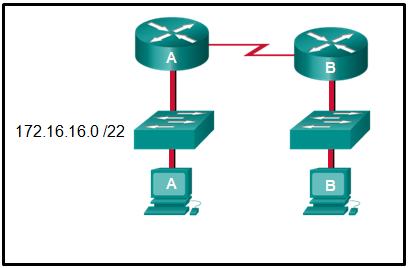
- 172.16.16.255
- 172.16.20.255
- 172.16.19.255
- 172.16.23.255
- 172.16.255.255
Explanation: The
172.16.16.0/22 network has 22 bits in the network portion and 10 bits in
the host portion. Converting the network address to binary yields a
subnet mask of 255.255.252.0. The range of addresses in this network
will end with the last address available before 172.16.20.0. Valid host
addresses for this network range from 172.16.16.1-172.16.19.254, making
172.16.19.255 the broadcast address.
13. A site administrator has been told that a particular
network at the site must accommodate 126 hosts. Which subnet mask would
be used that contains the required number of host bits?
- 255.255.255.0
- 255.255.255.128
- 255.255.255.224
- 255.255.255.240
Explanation: The
subnet mask of 255.255.255.0 has 8 host bits. The mask of
255.255.255.128 results in 7 host bits. The mask of 255.255.255.224 has 5
host bits. Finally, 255.255.255.240 represents 4 host bits.
14. Refer to the exhibit. Considering the addresses already
used and having to remain within the 10.16.10.0/24 network range, which
subnet address could be assigned to the network containing 25 hosts?
- 10.16.10.160/26
- 10.16.10.128/28
- 10.16.10.64/27
- 10.16.10.224/26
- 10.16.10.240/27
- 10.16.10.240/28
Explanation:
Addresses 10.16.10.0 through 10.16.10.63 are taken for the leftmost
network. Addresses 10.16.10.192 through 10.16.10.207 are used by the
center network.The address space from 208-255 assumes a /28 mask, which
does not allow enough host bits to accommodate 25 host addresses.The
address ranges that are available include 10.16.10.64/26
and10.16.10.128/26. To accommodate 25 hosts, 5 host bits are needed, so a
/27 mask is necessary. Four possible /27 subnets could be created from
the available addresses between 10.16.10.64 and 10.16.10.191:
10.16.10.64/27
10.16.10.96/27
10.16.10.128/27
10.16.10.160/27
15. What is the usable number of host IP addresses on a network that has a /26 mask?
Explanation: A /26
mask is the same as 255.255.255.192. The mask leaves 6 host bits. With 6
host bits, 64 IP addresses are possible. One address represents the
subnet number and one address represents the broadcast address, which
means that 62 addresses can then be used to assign to network devices.
16. Which address prefix range is reserved for IPv4 multicast?
- 240.0.0.0 – 254.255.255.255
- 224.0.0.0 – 239.255.255.255
- 169.254.0.0 – 169.254.255.255
- 127.0.0.0 – 127.255.255.255
17. Refer to the exhibit. Match the network with the correct
IP address and prefix that will satisfy the usable host addressing
requirements for each network.
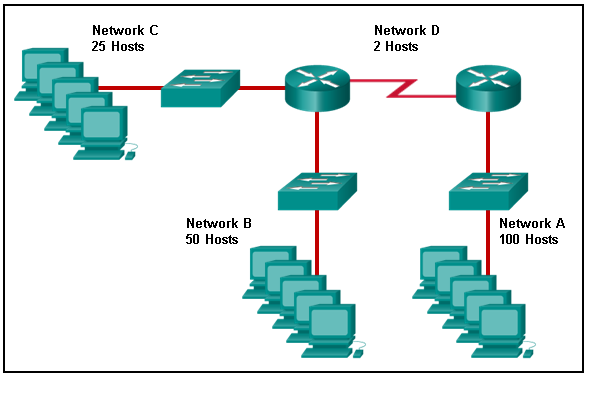
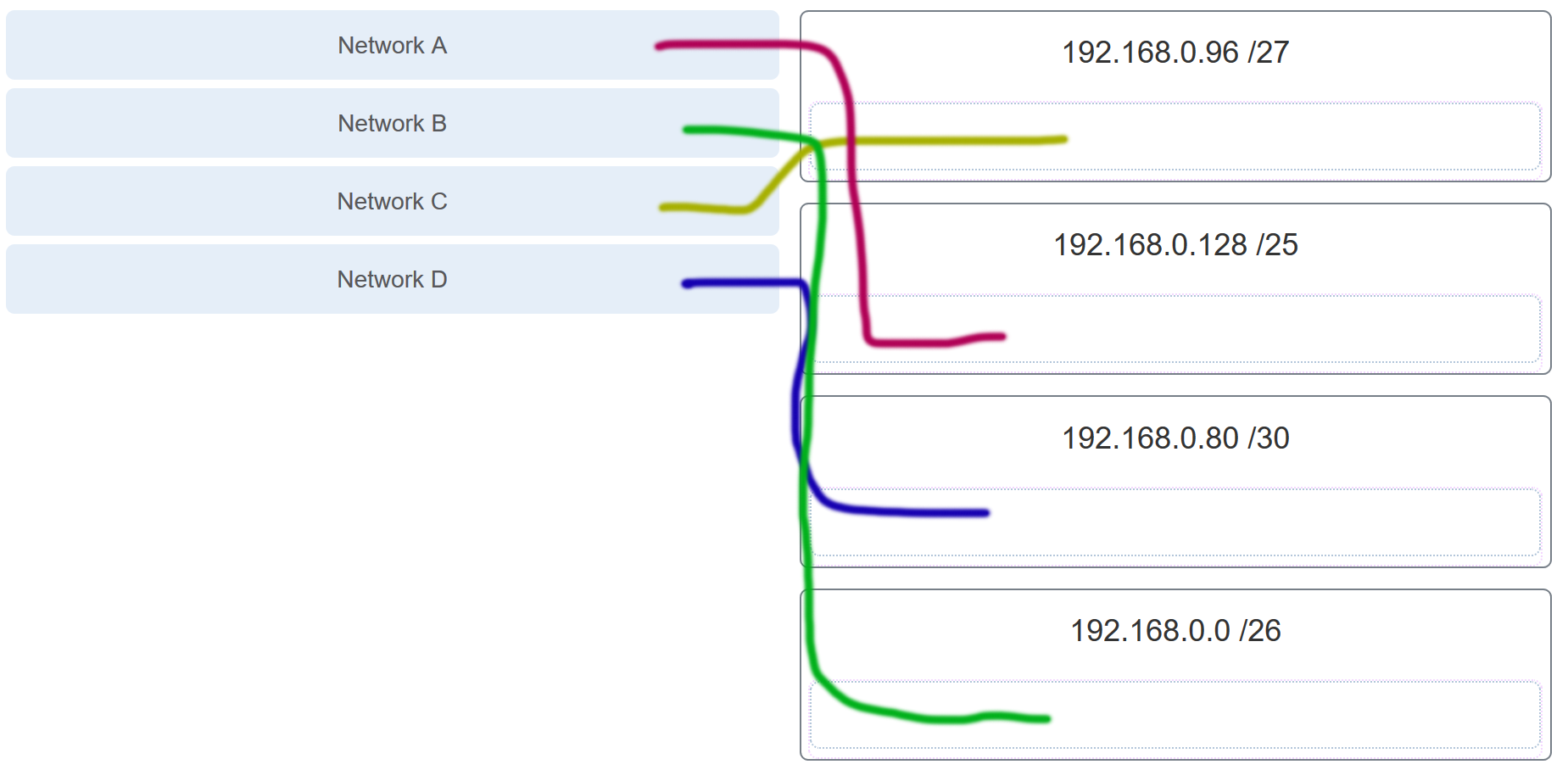
Explanation: Network A needs to use 192.168.0.128 /25, which yields 128 host addresses.
Network B needs to use 192.168.0.0 /26, which yields 64 host addresses.
Network C needs to use 192.168.0.96 /27, which yields 32 host addresses.
Network D needs to use 192.168.0.80/30, which yields 4 host addresses.
18. A high school in New York (school A) is using
videoconferencing technology to establish student interactions with
another high school (school B) in Russia. The videoconferencing is
conducted between two end devices through the Internet. The network
administrator of school A configures the end device with the IP address
209.165.201.10. The administrator sends a request for the IP address for
the end device in school B and the response is 192.168.25.10. Neither
school is using a VPN. The administrator knows immediately that this IP
will not work. Why?
- This is a loopback address.
- This is a link-local address.
- This is a private IP address.
- There is an IP address conflict.
19. Which three addresses are valid public addresses? (Choose three.)
- 198.133.219.17
- 192.168.1.245
- 10.15.250.5
- 128.107.12.117
- 172.31.1.25
- 64.104.78.227
Explanation: The ranges of private IPv4 addresses are as folllows:
10.0.0.0 – 10.255.255.255
172.16.0.0 – 172.31.255.255
192.168.0.0 – 192.168.255.255
20. A message is sent to all hosts on a remote network. Which type of message is it?
- limited broadcast
- multicast
- directed broadcast
- unicast
Explanation: A
directed broadcast is a message sent to all hosts on a specific network.
It is useful for sending a broadcast to all hosts on a nonlocal
network. A multicast message is a message sent to a selected group of
hosts that are part of a subscribing multicast group. A limited
broadcast is used for a communication that is limited to the hosts on
the local network. A unicast message is a message sent from one host to
another.
21. A company has a network address of 192.168.1.64 with a
subnet mask of 255.255.255.192. The company wants to create two
subnetworks that would contain 10 hosts and 18 hosts respectively. Which
two networks would achieve that? (Choose two.)
- 192.168.1.16/28
- 192.168.1.64/27
- 192.168.1.128/27
- 192.168.1.96/28
- 192.168.1.192/28
22. Which address is a valid IPv6 link-local unicast address?
- FEC8:1::FFFF
- FD80::1:1234
- FE80::1:4545:6578:ABC1
- FE0A::100:7788:998F
- FC90:5678:4251:FFFF
Explanation: IPv6
LLAs are in the fe80::/10 range. The /10 indicates that the first 10
bits are 1111 1110 10xx xxxx. The first hextet has a range of 1111 1110
1000 0000 (fe80) to 1111 1110 1011 1111 (febf).
23. Which of these addresses is the shortest abbreviation for the IP address:
3FFE:1044:0000:0000:00AB:0000:0000:0057?
- 3FFE:1044::AB::57
- 3FFE:1044::00AB::0057
- 3FFE:1044:0:0:AB::57
- 3FFE:1044:0:0:00AB::0057
- 3FFE:1044:0000:0000:00AB::57
- 3FFE:1044:0000:0000:00AB::0057
Explanation: The rules for reducing the notation of IPv6 addresses are:
1. Omit any leading 0s (zeros) in any hextet.
2. Replace any single, contiguous string of one or more 16-bit hextets consisting of all zeros with a double colon (::) .
3. The double colon (::) can only be used once within an address.
24. A network administrator has received the IPv6 prefix
2001:DB8::/48 for subnetting. Assuming the administrator does not subnet
into the interface ID portion of the address space, how many subnets
can the administrator create from the /48 prefix?
Explanation: With a
network prefix of 48, there will be 16 bits available for subnetting
because the interface ID starts at bit 64. Sixteen bits will yield 65536
subnets.
25. Given IPv6 address prefix 2001:db8::/48, what will be the
last subnet that is created if the subnet prefix is changed to /52?
- 2001:db8:0:f00::/52
- 2001:db8:0:8000::/52
- 2001:db8:0:f::/52
- 2001:db8:0:f000::/52
Explanation: Prefix
2001:db8::/48 has 48 network bits. If we subnet to a /52, we are moving
the network boundary four bits to the right and creating 16 subnets.
The first subnet is 2001:db8::/52 the last subnet is
2001:db8:0:f000::/52.
26. Consider the following range of addresses:
2001:0DB8:BC15:00A0:0000::
2001:0DB8:BC15:00A1:0000::
2001:0DB8:BC15:00A2:0000::
…
2001:0DB8:BC15:00AF:0000::
The prefix-length for the range of addresses is /60 .
Explanation: All
the addresses have the part 2001:0DB8:BC15:00A in common. Each number or
letter in the address represents 4 bits, so the prefix-length is /60.
27. What type of IPv6 address is FE80::1?
- loopback
- link-local
- multicast
- global unicast
28. Refer to the exhibit. A company is deploying an IPv6
addressing scheme for its network. The company design document indicates
that the subnet portion of the IPv6 addresses is used for the new
hierarchical network design, with the site subsection to represent
multiple geographical sites of the company, the sub-site section to
represent multiple campuses at each site, and the subnet section to
indicate each network segment separated by routers. With such a scheme,
what is the maximum number of subnets achieved per sub-site?
Explanation:
Because only one hexadecimal character is used to represent the subnet,
that one character can represent 16 different values 0 through F.
29. What is used in the EUI-64 process to create an IPv6 interface ID on an IPv6 enabled interface?
- the MAC address of the IPv6 enabled interface
- a randomly generated 64-bit hexadecimal address
- an IPv6 address that is provided by a DHCPv6 server
- an IPv4 address that is configured on the interface
Explanation: The
EUI-64 process uses the MAC address of an interface to construct an
interface ID (IID). Because the MAC address is only 48 bits in length,
16 additional bits (FF:FE) must be added to the MAC address to create
the full 64-bit interface ID.
30. What is the prefix for the host address 2001:DB8:BC15:A:12AB::1/64?
- 2001:DB8:BC15
- 2001:DB8:BC15:A
- 2001:DB8:BC15:A:1
- 2001:DB8:BC15:A:12
31. An IPv6 enabled device sends a data packet with the destination address of FF02::1. What is the target of this packet?
- the one IPv6 device on the link that has been uniquely configured with this address
- all IPv6 enabled devices on the local link or network
- only IPv6 DHCP servers
- only IPv6 configured routers
32. Match the IPv6 address with the IPv6 address type. (Not all options are used.)
Explanation: FF02::1:FFAE:F85F is a solicited node multicast address.
2001:DB8::BAF:3F57:FE94 is a global unicast address.
FF02::1 is the all node multicast address. Packets sent to this address will be received by all IPv6 hosts on the local link.
::1 is the IPv6 loopback address.
There are no examples of link local or unique local addresses provided.
33. Which IPv6 prefix is reserved for communication between devices on the same link?
- FC00::/7
- 2001::/32
- FE80::/10
- FDFF::/7
Explanation: IPv6
link-local unicast addresses are in the FE80::/10 prefix range and are
not routable. They are used only for communications between devices on
the same link.
34. Which type of IPv6 address refers to any unicast address that is assigned to multiple hosts?
- unique local
- global unicast
- link-local
- anycast
35. What are two types of IPv6 unicast addresses? (Choose two.)
- multicast
- loopback
- link-local
- anycast
- broadcast
Explanation:
Multicast, anycast, and unicast are types of IPv6 addresses. There is no
broadcast address in IPv6. Loopback and link-local are specific types
of unicast addresses.
36. Which service provides dynamic global IPv6 addressing to
end devices without using a server that keeps a record of available IPv6
addresses?
- stateful DHCPv6
- SLAAC
- static IPv6 addressing
- stateless DHCPv6
Explanation: Using
stateless address autoconfiguration (SLAAC), a PC can solicit a router
and receive the prefix length of the network. From this information the
PC can then create its own IPv6 global unicast address.
37. Which protocol supports Stateless Address Autoconfiguration (SLAAC) for dynamic assignment of IPv6 addresses to a host?
Explanation: SLAAC
uses ICMPv6 messages when dynamically assigning an IPv6 address to a
host. DHCPv6 is an alternate method of assigning an IPv6 addresses to a
host. ARPv6 does not exist. Neighbor Discovery Protocol (NDP) provides
the functionality of ARP for IPv6 networks. UDP is the transport layer
protocol used by DHCPv6.
38. Three methods allow IPv6 and IPv4 to co-exist. Match each method with its description. (Not all options are used.)
39. A technician uses the ping 127.0.0.1 command. What is the technician testing?
- the TCP/IP stack on a network host
- connectivity between two adjacent Cisco devices
- connectivity between a PC and the default gateway
- connectivity between two PCs on the same network
- physical connectivity of a particular PC and the network
40. Refer to the exhibit. An administrator is trying to
troubleshoot connectivity between PC1 and PC2 and uses the tracert
command from PC1 to do it. Based on the displayed output, where should
the administrator begin troubleshooting?
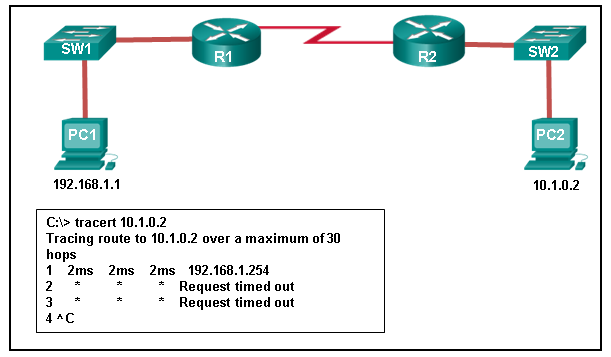 41. Which protocol is used by the traceroute command to send and receive echo-requests and echo-replies?
41. Which protocol is used by the traceroute command to send and receive echo-requests and echo-replies?
Explanation: Traceroute uses the ICMP (Internet Control Message Protocol) to send and receive echo-request and echo-reply messages.
42. Which ICMPv6 message is sent when the IPv6 hop limit
field of a packet is decremented to zero and the packet cannot be
forwarded?
- network unreachable
- time exceeded
- protocol unreachable
- port unreachable
43. A user executes a traceroute over IPv6. At what point would a router in the path to the destination device drop the packet?
- when the value of the Hop Limit field reaches 255
- when the value of the Hop Limit field reaches zero
- when the router receives an ICMP time exceeded message
- when the target host responds with an ICMP echo reply message
44. What is the purpose of ICMP messages?
- to inform routers about network topology changes
- to ensure the delivery of an IP packet
- to provide feedback of IP packet transmissions
- to monitor the process of a domain name to IP address resolution
Explanation: The purpose of ICMP messages is to provide feedback about issues that are related to the processing of IP packets.
45. What source IP address does a router use by default when the traceroute command is issued?
- the highest configured IP address on the router
- a loopback IP address
- the IP address of the outbound interface
- the lowest configured IP address on the router
Explanation: When
sending an echo request message, a router will use the IP address of the
exit interface as the source IP address. This default behavior can be
changed by using an extended ping and specifying a specific source IP
address.
46. Match each description with an appropriate IP address. (Not all options are used.)
Explanation:
Link-Local addresses are assigned automatically by the OS environment
and are located in the block 169.254.0.0/16. The private addresses
ranges are 10.0.0.0/8, 172.16.0.0/12, and 192.168.0.0/16. TEST-NET
addresses belong to the range 192.0.2.0/24. The addresses in the block
240.0.0.0 to 255.255.255.254 are reserved as experimental addresses.
Loopback addresses belong to the block 127.0.0.0/8.
47. A user issues a ping 192.135.250.103 command and receives
a response that includes a code of 1. What does this code represent?
- host unreachable
- protocol unreachable
- port unreachable
- network unreachable
48. Which subnet would include the address 192.168.1.96 as a usable host address?
- 192.168.1.64/26
- 192.168.1.32/27
- 192.168.1.32/28
- 192.168.1.64/29
Explanation: For
the subnet of 192.168.1.64/26, there are 6 bits for host addresses,
yielding 64 possible addresses. However, the first and last subnets are
the network and broadcast addresses for this subnet. Therefore, the
range of host addresses for this subnet is 192.168.1.65 to
192.168.1.126. The other subnets do not contain the address 192.168.1.96
as a valid host address.
49. Open the PT Activity. Perform the tasks in the activity instructions and then answer the question.
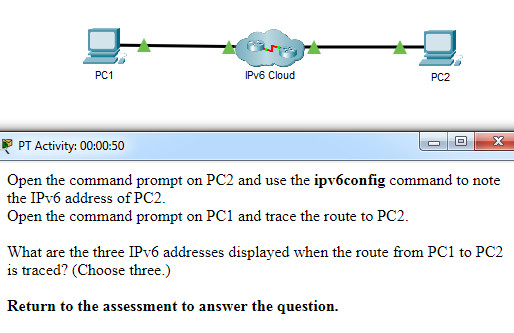
CCNA 1 v7 Modules 11 – 13 IP Addressing Exam Answers Full
What are the three IPv6 addresses displayed when the route from PC1 to PC2 is traced? (Choose three.)
- 2001:DB8:1:1::1
- 2001:DB8:1:1::A
- 2001:DB8:1:2::2
- 2001:DB8:1:2::1
- 2001:DB8:1:3::1
- 2001:DB8:1:3::2
- 2001:DB8:1:4::1
Explanation: Using the ipv6config command
on PC2 displays the IPv6 address of PC2, which is 2001:DB8:1:4::A. The
IPV6 link-local address, FE80::260:70FF:FE34:6930, is not used in route
tracing. Using the tracert 2001:DB8:1:4::A command on PC1 displays four addresses: 2001:DB8:1:1::1, 2001:DB8:1:2::1 , 2001:DB8:1:3::2, and 2001:DB8:1:4::A.
50. A host is transmitting a broadcast. Which host or hosts will receive it?
- all hosts in the same subnet
- a specially defined group of hosts
- the closest neighbor on the same network
- all hosts on the Internet
51. A host is transmitting a unicast. Which host or hosts will receive it?
- one specific host
- a specially defined group of hosts
- all hosts on the Internet
- the closest neighbor on the same network
52. A user issues a ping 2001:db8:FACE:39::10 command and
receives a response that includes a code of 3. What does this code
represent?
- address unreachable
- network unreachable
- host unreachable
- protocol unreachable
53. A host is transmitting a multicast. Which host or hosts will receive it?
- a specially defined group of hosts
- one specific host
- all hosts with the same IP address
- the closest neighbor on the same network
54. A host is transmitting a multicast. Which host or hosts will receive it?
- a specially defined group of hosts
- one specific host
- directly connected network devices
- the closest neighbor on the same network
55. A host is transmitting a multicast. Which host or hosts will receive it?
- a specially defined group of hosts
- one specific host
- all hosts with the same IP address
- all hosts on the Internet
56. A host is transmitting a multicast. Which host or hosts will receive it?
- a specially defined group of hosts
- one specific host
- directly connected network devices
- all hosts on the Internet
57. A host is transmitting a multicast. Which host or hosts will receive it?
- a specially defined group of hosts
- all hosts in the same subnet
- directly connected network devices
- the closest neighbor on the same network
58. A host is transmitting a broadcast. Which host or hosts will receive it?
- all hosts in the same subnet
- one specific host
- the closest neighbor on the same network
- directly connected network devices
59. A host is transmitting a broadcast. Which host or hosts will receive it?
- all hosts in the same subnet
- one specific host
- all hosts on the Internet
- directly connected network devices
60. Which is the compressed format of the IPv6 address 2001:0db8:0000:0000:0000:a0b0:0008:0001?
- 2001:db8::a0b0:8:1
- 2001:db8::ab8:1:0:1000
- 2001:db80:0:1::80:1
- 2001:db80:::1::80:1
61. Which is the compressed format of the IPv6 address fe80:09ea:0000:2200:0000:0000:0fe0:0290?
- fe80:9ea:0:2200::fe0:290
- fe80:9:20::b000:290
- fe80:9ea0::2020:0:bf:e0:9290
- fe80:9ea0::2020::bf:e0:9290
62. Which is the compressed format of the IPv6 address 2002:0042:0010:c400:0000:0000:0000:0909?
- 2002:42:10:c400::909
- 200:420:110:c4b::910:0:90
- 2002:4200::25:1090:0:99
- 2002:42::25:1090:0:99
63. Which is the compressed format of the IPv6 address 2001:0db8:0000:0000:0ab8:0001:0000:1000?
- 2001:db8::ab8:1:0:1000
- 2001:db8::a0b0:8:1
- 2001:db8:1::ab8:0:1
- 2001:db8:0:1::8:1
64. Which is the compressed format of the IPv6 address 2002:0420:00c4:1008:0025:0190:0000:0990?
- 2002:420:c4:1008:25:190::990
- 2002:42:10:c400::909
- 2002:4200::25:1090:0:99
- 2002:42::25:1090:0:99
65. Which is the compressed format of the IPv6 address 2001:0db8:0000:0000:0000:a0b0:0008:0001?
- 2001:db8::a0b0:8:1
- 2001:db8:1::ab8:0:1
- 2001:db8::ab8:1:0:1000
- 2001:db8:0:1::8:1
66. Which is the compressed format of the IPv6 address fe80:0000:0000:0000:0220:0b3f:f0e0:0029?
- fe80::220:b3f:f0e0:29
- fe80:9ea:0:2200::fe0:290
- fe80:9ea0::2020:0:bf:e0:9290
- fe80:9ea0::2020::bf:e0:9290
67. Which is the compressed format of the IPv6 address 2001:0db8:0000:0000:0000:a0b0:0008:0001?
- 2001:db8::a0b0:8:1
- 2001:db8::ab8:1:0:1000
- 2001:db80:0:1::80:1
- 2001:db8:0:1::8:1
68. Which is the compressed format of the IPv6 address 2002:0042:0010:c400:0000:0000:0000:0909?
- 2002:42:10:c400::909
- 2002:4200::25:1090:0:99
- 2002:420:c4:1008:25:190::990
- 2002:42::25:1090:0:99
69. Which is the compressed format of the IPv6 address fe80:09ea:0000:2200:0000:0000:0fe0:0290?
- fe80:9ea:0:2200::fe0:290
- fe80:9ea0::2020:0:bf:e0:9290
- fe80::220:b3f:f0e0:29
- fe80::0220:0b3f:f0e0:0029
70. A user issues a ping 2001:db8:FACE:39::10 command and
receives a response that includes a code of 2 . What does this code
represent?
- beyond scope of the source address
- communication with the destination administratively prohibited
- address unreachable
- no route to destination
71. A user issues a ping 192.135.250.103 command and receives
a response that includes a code of 1. What does this code represent?
- host unreachable
- beyond scope of the source address
- address unreachable
- communication with the destination administratively prohibited
72. A user issues a ping fe80:65ab:dcc1::100 command and
receives a response that includes a code of 3. What does this code
represent?
- address unreachable
- communication with the destination administratively prohibited
- beyond scope of the source address
- no route to destination
73. A user issues a ping 10.10.14.67 command and receives a response that includes a code of 0. What does this code represent?
- network unreachable
- protocol unreachable
- port unreachable
- host unreachable
74. A user issues a ping fe80:65ab:dcc1::100 command and
receives a response that includes a code of 4. What does this code
represent?
- port unreachable
- host unreachable
- protocol unreachable
- network unreachable
75. A user issues a ping 198.133.219.8 command and receives a response that includes a code of 0. What does this code represent?
- network unreachable
- protocol unreachable
- port unreachable
- host unreachable
76. A user issues a ping 2001:db8:3040:114::88 command and
receives a response that includes a code of 4. What does this code
represent?
- port unreachable
- host unreachable
- protocol unreachable
- network unreachable
77. A user issues a ping 2001:db8:FACE:39::10 command and
receives a response that includes a code of 2. What does this code
represent?
- beyond scope of the source address
- host unreachable
- protocol unreachable
- network unreachable
















0 commentaires:
Enregistrer un commentaire